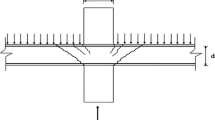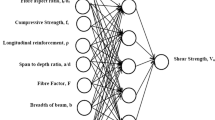Abstract
This paper aims to develop a practical artificial neural network (ANN) model for predicting the punching shear strength (PSS) of two-way reinforced concrete slabs. In this regard, a total of 218 test results collected from the literature were used to develop the ANN models. Accordingly, the slab thickness, the width of the column section, the effective depth of the slab, the reinforcement ratio, the compressive strength of concrete, and the yield strength of reinforcement were considered as input variables. Meanwhile, the PSS was considered as the output variable. Several ANN models were developed, but the best model with the highest coefficient of determination (R2) and the smallest root mean square errors was retained. The performance of the best ANN model was compared with multiple linear regression and existing design code equations. The comparative results showed that the proposed ANN model was provided the most accurate prediction of PSS of two-way reinforced concrete slabs. The parametric study was carried out using the proposed ANN model to assess the effect of each input parameter on the PSS of two-way reinforced concrete slabs. Finally, a graphical user interface was developed to apply for practical design of PSS of two-way reinforced concrete slabs.





















Similar content being viewed by others
References
Adom-Asamoah M, Kankam CK (2008) Behaviour of reinforced concrete two-way slabs using steel bars milled from scrap metals. Mater Des 29:1125–1130
Elstner RC, Hognestad E (1956) Shearing strength of reinforced concrete slabs. J Proc 20:29–58
Moe J (1961) Shearing strength of reinforced concrete slabs and footings under concentrated loads. Portland Cement Association, Research and Development Laboratories
Mowrer R, Vanderbilt M (1967) Shear strength of lightweight aggregate reinforced concrete flat plates. J Proc 20:722–729
Regan P (1986) Symmetric punching of reinforced concrete slabs. Mag Concret Res 38:115–128
Guandalini S, Burdet O, Muttoni A (2009) Punching tests of slabs with low reinforcement ratios. ACI Struct J 106(1):87–95
Sagaseta J, Muttoni A, Fernández Ruiz M, Tassinari L (2011) Non-axis-symmetrical punching shear around internal columns of RC slabs without transverse reinforcement. Mag Concret Res 1000098:17
Marzouk H, Hussein A (1991) Experimental investigation on the behavior of high-strength concrete slabs. ACI Struct J 88:701–713
Lips S, Fernández Ruiz M, Muttoni A (2012) Experimental investigation on punching strength and deformation capacity of shear-reinforced slabs. ACI Struct J 109:889–900
Theodorakopoulos D, Swamy R (2002) Ultimate punching shear strength analysis of slab–column connections. Cement Concr Compos 24:509–521
Metwally IM, Issa MS, El-Betar SA (2008) Punching shear resistance of normal and high strength reinforced concrete flat slabs. Civ Eng Res Mag 30:982–1004
Ozden S, Ersoy U, Ozturan T (2006) Punching shear tests of normal-and high-strength concrete flat plates. Can J Civ Eng 33:1389–1400
Birkle G, Dilger WH (2008) Influence of slab thickness on punching shear strength. ACI Struct J 105:180
Hegger J, Ricker M, Sherif AG, Windisch A (2010) Punching strength of reinforced concrete footings. ACI Struct J 107:494–496
Rizk E, Marzouk H, Hussein A (2011) Punching shear of thick plates with and without shear reinforcement. ACI Struct J 108:581
ACI Committee 318 (2014) Building Code Requirements for Structural Concrete (ACI 318–14). Farmington Hills, MI: American Concrete Institute
Bs B (1997) Structural use of concrete, Part 1: code of practice for design and construction. British Standards Institution, UK
FIB MC (2010) Model code 2010—final draft, vol 1. Bulletins: Lausanne, Switzerland
Narayanan R, Beeby A (2005) Designers’ guide to EN 1992-1-1 and EN 1992-1-2. Eurocode 2: design of concrete structures: general rules and rules for buildings and structural fire design. Thomas Telford, London
Naderpour H, Mirrashid M (2019) A neuro-fuzzy model for punching shear prediction of slab-column connections reinforced with FRP. Soft Comput Civ Eng 3:16–26
Chanda MM, Bandyopadhyay G, Banerjee N (2019) Analysis and estimation of foreign exchange reserves of India using soft computing techniques. IIMB Manag Rev. https://doi.org/10.1016/j.iimb.2019.10.010
Yan Y, Wang L, Wang T, Wang X, Hu Y, Duan Q (2018) Application of soft computing techniques to multiphase flow measurement: a review. Flow Meas Instrum 60:30–43
Saridakis KM, Dentsoras AJ (2008) Soft computing in engineering design—a review. Adv Eng Inform 22:202–221
Salajegheh E, Gholizadeh S (2005) Optimum design of structures by an improved genetic algorithm using neural networks. Adv Eng Softw 36:757–767
Gandomi AH, Roke DA (2015) Assessment of artificial neural network and genetic programming as predictive tools. Adv Eng Softw 88:63–72
Asteris PG, Plevris V (2017) Anisotropic masonry failure criterion using artificial neural networks. Neural Comput Appl 28:2207–2229
Bahmania Z, Ghasemib MR, Mousaviamjadc SS, Gharehbaghid S (2019) Prediction of performance point of semi-rigid steel frames using artificial neural networks. Int J Intell Syst Appl 10:42–53
Tran V-L, Thai D-K, Kim S-E (2019) A new empirical formula for prediction of the axial compression capacity of CCFT columns. Steel Compos Struct 33:181–194
Hoang N-D (2019) Estimating punching shear capacity of steel fibre reinforced concrete slabs using sequential piecewise multiple linear regression and artificial neural network. Measurement 137:58–70
Akbarpour H, Akbarpour M (2017) Prediction of punching shear strength of two-way slabs using artificial neural network and adaptive neuro-fuzzy inference system. Neural Comput Appl 28:3273–3284
Abambres M, Lantsoght E (2018) Neural network-based formula for shear capacity prediction of one-way slabs under concentrated loads. SSRN 3368676
Metwally IM (2013) Prediction of punching shear capacities of two-way concrete slabs reinforced with FRP bars. HBRC J 9:125–133
Menétrey P (2002) Synthesis of punching failure in reinforced concrete. Cement Concr Compos 24:497–507
Rochdi E, Bigaud D, Ferrier E, Hamelin P (2006) Ultimate behavior of CFRP strengthened RC flat slabs under a centrally applied load. Compos Struct 72:69–78
Park R, Gamble WL (1999) Reinforced concrete slabs. Wiley, Oxford
Kinnunen S, Nylander H (1960) Punching of concrete slabs without shear reinforcement. Elander, New York
Yitzhaki D (1966) Punching strength of reinforced concrete slabs. J Proc 20:527–542
Kinnunen S, Nylander H, Tolf P (1978) Investigations on punching at the division of building statics and structural engineering. Nordisk Betong 3:25–27
Regan P, Walker P, Zakaria K (1979) Tests of reinforced concrete flat slabs. CIRIA Proj RP 20:220
Rankin G, Long A (1987) Predicting the punching strength of conventional slab-column specimens. Proc Inst Civ Eng 82:327–346
PT (1988) Plattjocklekens inverkan pøa betongplattors høallfasthet vid genomstansning Försök med cirkulära platter. Department of Structural Mechanics and Engineering Royal Institute of Technology. Bulletin No. 146, Stockholm, p 64
Gardner N (1990) Relationship of the punching shear capacity of reinforced concrete slabs with concrete strength. Struct J 87:66–71
Tomaszewicz A (1993) Punching shear capacity of reinforced concrete slabs. High strength concrete SP2-plates and shells. Report 2.3. Report No STF70A93082 SINTEF Trondheim
Hallgren M (1998) Punching shear capacity of reinforced high-strength concrete slabs. Royal Institute Of Technology
Ramdane K (1996) Punching shear of high performance concrete slabs. In: Proceedings of the fourth international symposium on utilization of high-strength/high performance concrete, pp 1015–26
Li KKL (2002) Influence of size on punching shear strength of concrete slabs. McGill University, Canada
Guandalini S, Muttoni A (2004) Symmetrical punching tests on slabs without transverse reinforcement. Test Report
Sundquist H, Kinnunen S (2004) The effect of column head and drop panels on the punching capacity of flat slabs Bulletin No. 82. Department of Civil and Architectural Engineering. Royal Institute of Technology, Stockholm
Hossin MA (2007) Crack analysis of reinforced concrete two-way slabs. Memorial University of Newfoundland, St. John’s
Marzouk R, Rizk E (2009) Punching analysis of reinforced concrete two-way slabs. Research Report RCS01, Faculty of Engineering and Applied Science, Memorial
Chapra SC, Canale RP (2010) Numerical methods for engineers. McGraw-Hill Higher Education, Boston
Vu-Bac N, Lahmer T, Zhang Y, Zhuang X, Rabczuk T (2014) Stochastic predictions of interfacial characteristic of polymeric nanocomposites (PNCs). Compos B Eng 59:80–95
Golafshani EM, Ashour A (2016) A feasibility study of BBP for predicting shear capacity of FRP reinforced concrete beams without stirrups. Adv Eng Softw 97:29–39
Hagan MT, Menhaj MB (1994) Training feedforward networks with the Marquardt algorithm. IEEE Trans Neural Netw 5:989–993
Naderpour H, Mirrashid M (2018) An innovative approach for compressive strength estimation of mortars having calcium inosilicate minerals. J Build Eng 19:205–215
Tran V-L, Thai D-K, Kim S-E (2019) Application of ANN in predicting ACC of SCFST column. Compos Struct 20:111332
Ilkhani M, Naderpour H, Kheyroddin A (2019) A proposed novel approach for torsional strength prediction of RC beams. J Build Eng 20:100810
Dilger W, Birkle G, Mitchell D (2005) Effect of flexural reinforcement on punching shear resistance. Spec Publ 232:57–74
Bažant ZP, Cao Z (1987) Size effect in punching shear failure of slabs. ACI Struct J 84:44–53
Acknowledgements
This research was supported by the National Research Foundation of Korea (NRF) funded by the Korea government (MSIT) (No. 2018R1A2A2A05018524 and No. 2019R1A4A1021702).
Author information
Authors and Affiliations
Corresponding author
Ethics declarations
Conflict of interest
The author(s) declared no potential conflicts of interest with respect to the research, authorship, and/or publication of this article.
Additional information
Publisher's Note
Springer Nature remains neutral with regard to jurisdictional claims in published maps and institutional affiliations.
Electronic supplementary material
Below is the link to the electronic supplementary material.
Rights and permissions
About this article
Cite this article
Tran, VL., Kim, SE. A practical ANN model for predicting the PSS of two-way reinforced concrete slabs. Engineering with Computers 37, 2303–2327 (2021). https://doi.org/10.1007/s00366-020-00944-w
Received:
Accepted:
Published:
Issue Date:
DOI: https://doi.org/10.1007/s00366-020-00944-w




